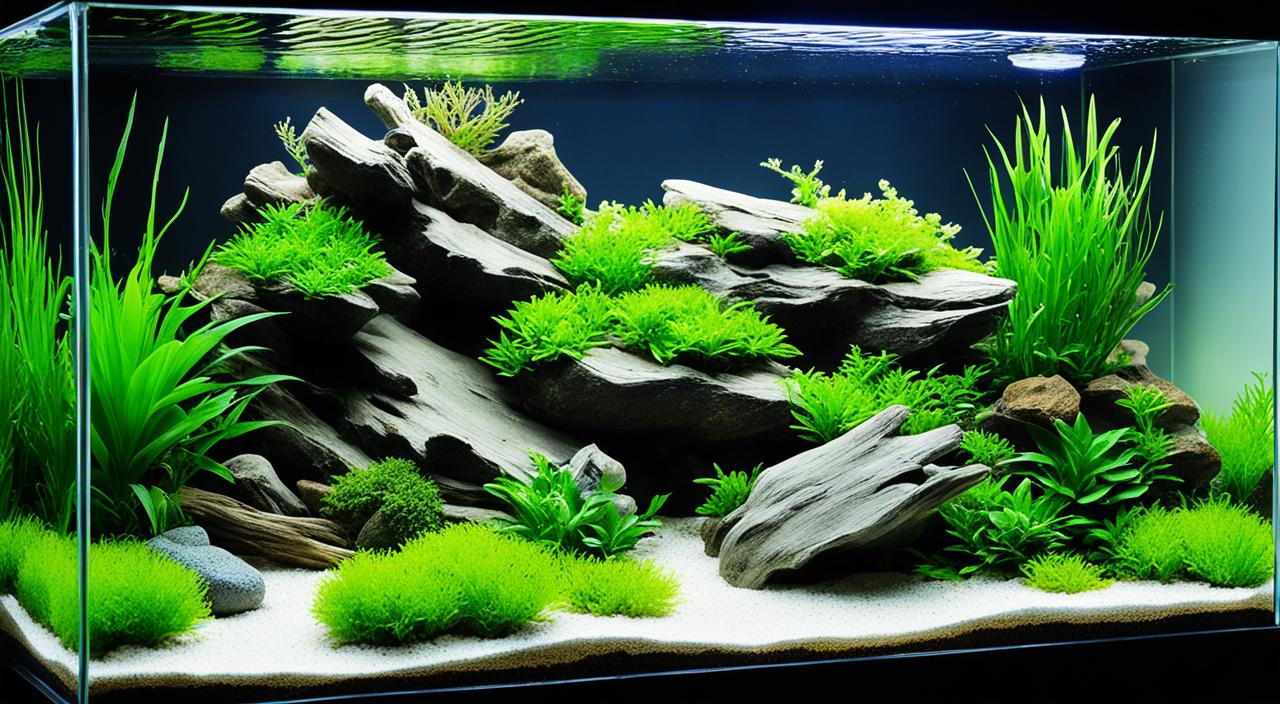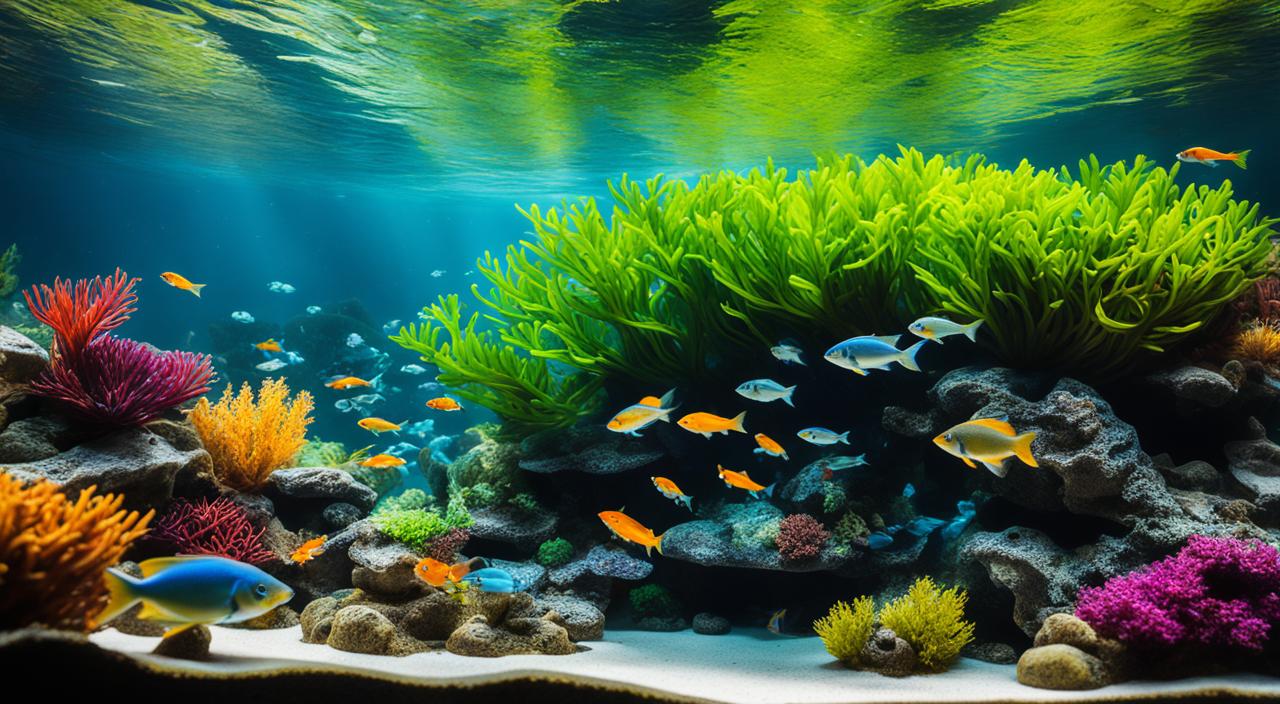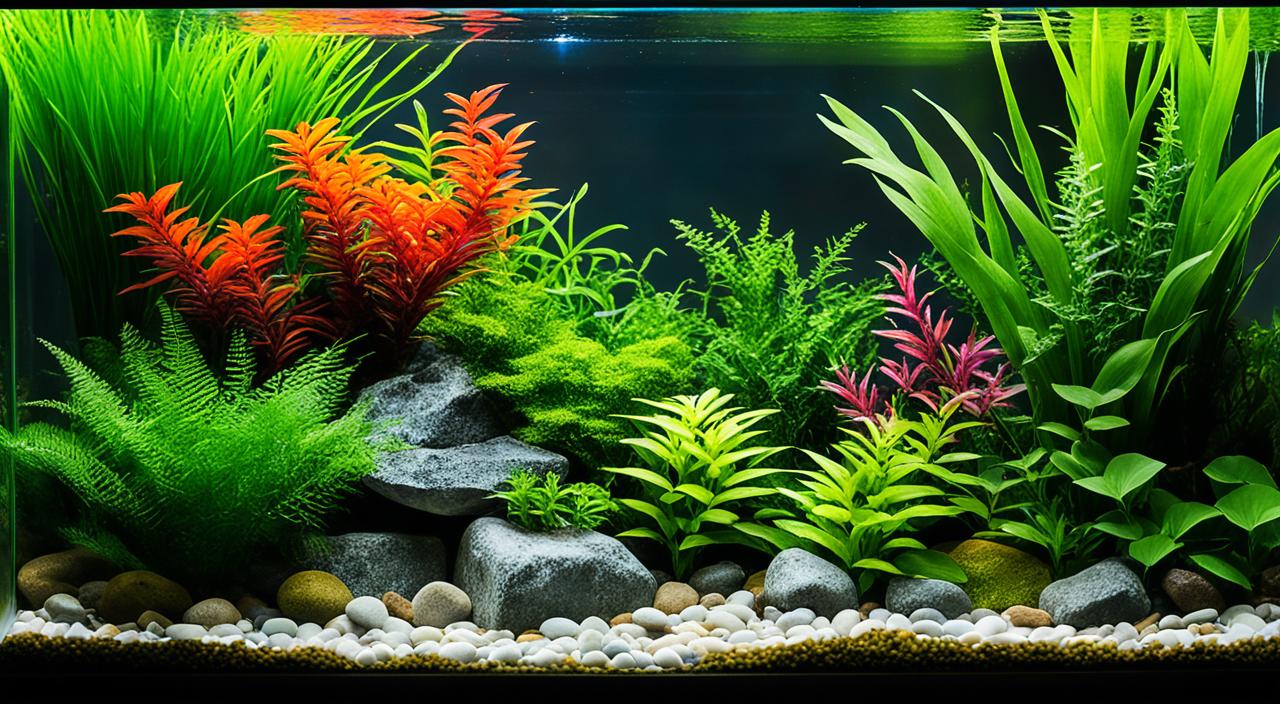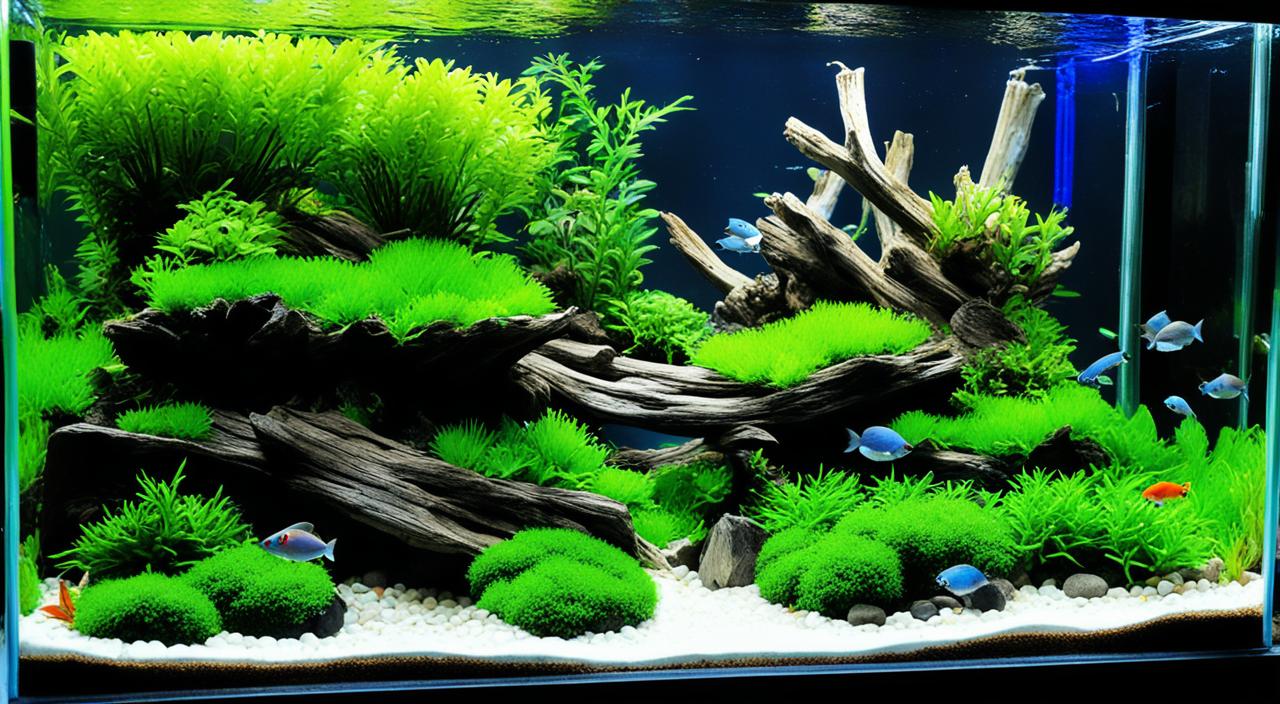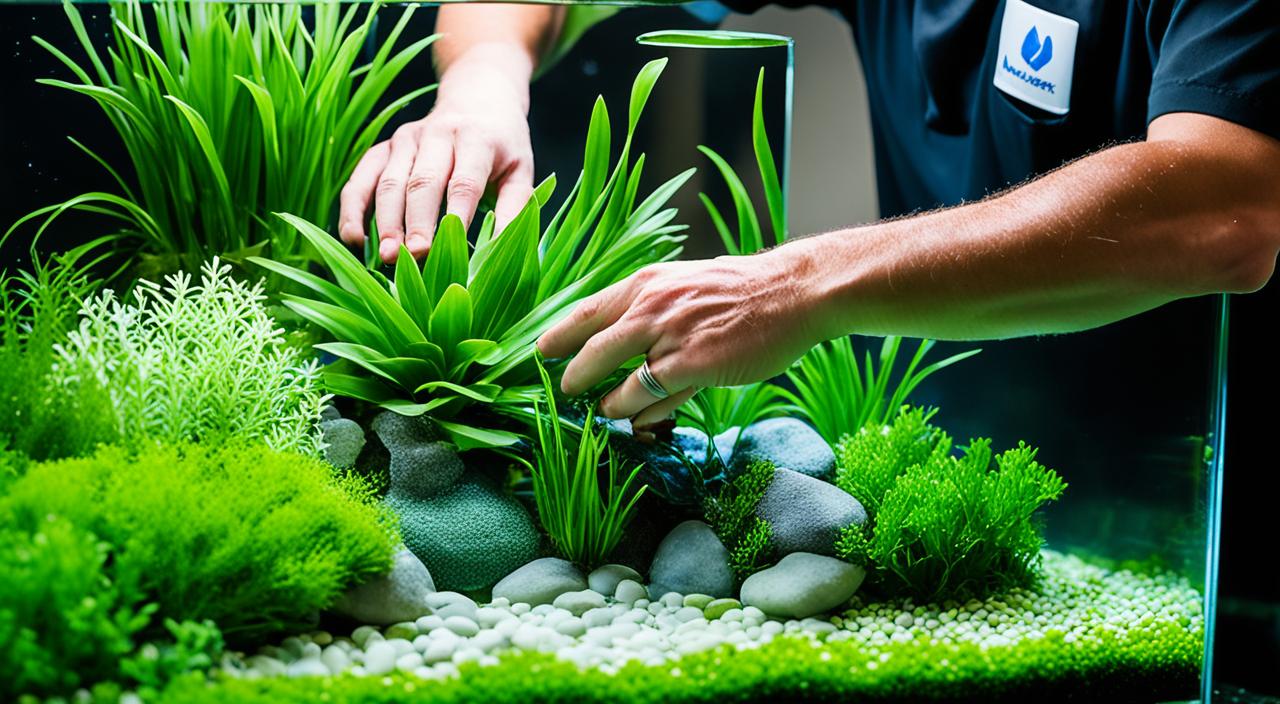As a gardening enthusiast inclined to creativity, my journey has led me to the transformative world of aquascaping. This aquascaping basics guide is curated for those embarking on the path of beginner’s aquascaping, aiming to unfold the layered beauty of an aquascape design. From the simple grass patches to the enchanting dance of waterfalls, my hands have crafted ponds and ecosystems that resonate with tranquillity and life. Aquascape ecosystem setup is more than a hobby; it’s a plunge into an art form where every pebble, plant, and drop of water narrates a story. Embark with me as we explore the fundamentals required to design your aquascape, a sanctuary that mirrors the serenity of nature’s design.
Sharing my insights, I invite you to grasp the essence of aquascaping—a blend of aesthetic allure and ecological mindfulness. Aquascaping is about nurturing a slice of nature right in your backyard, creating a harmonious escape where every element coexists in a delicate balance. It’s about making a place where the whispers of water bring peace, glistening fish glide under the lush foliage, and every glance holds a breath of life. Through this guide, I am excited to help you mould your dreamscape into an aquatic reality step by step.
Key Takeaways
- Aquascaping offers a blend of gardening with artistic water feature design.
- Beginner’s aquascaping can be easily mastered with the proper guidance and setup.
- Aquascape designs add stunning visual appeal and serenity to any backyard space.
- Understanding aquascape ecosystem setup is critical to creating a self-sustaining aquatic environment.
- Developing a thoughtful plan is paramount for a successful aquascape design.
- Aquascapes can support diverse plant and animal life, enhancing local biodiversity.
Exploring the Art of Aquascaping
Aquascaping, the art I delve into passionately, is much akin to painting, except here, my canvas thrives with water and life. Crafting an underwater scenery filled with meticulously arranged foliage, stones, and possibly even fish reflects a blend of my love for gardening and an affinity towards the underwater essence of nature.
As I share my approach to embedding tranquillity within a personalized aquatic landscape, I aim to lay the foundation for beginners to erect their artful water features using various aquascaping techniques and embracing diverse aquascaping styles to reflect their vision.
What is Aquascaping?
In my aquascape endeavours, I play with various themes and am guided by aquascape balance principles to create a serene habitat. Aquascaping is not just a method but a creative process that involves designing, planning, and carefully orchestrating a balanced ecosystem beneath the water’s surface. A harmonious interplay of colour, texture, and space frames my water garden, showcasing my aesthetic in a fluid motion.
Benefits of a Personal Aquatic Landscape
Immersing myself in aquascaping transcends mere hobby—it’s a therapeutic journey. The personal aquatic landscapes I construct offer a refuge from the hustle of daily life, enveloping my senses in a calm state. Beyond aesthetics, these living water features attract a flourish of wildlife, foster a self-sustaining ecosystem, and serve as a contemplative nook where the ripples and reflections spin tales of zen and tranquillity.
- Experiencing therapeutic benefits through the serenity of moving water
- Adopting various aquascaping theme ideas to personalize and enhance my backyard’s aesthetic
- Contributing to biodiversity by creating a natural haven for local wildlife
- Infusing my outdoor space with a unique art form that reflects my creative vision
The binding of these elements and the enjoyment they foster fuel my relentless pursuit of designing aquascapes that are as much a sanctuary for the mind and soul as they are a feast for the eyes.
Aquascaping Guide: Essential Equipment for Starters
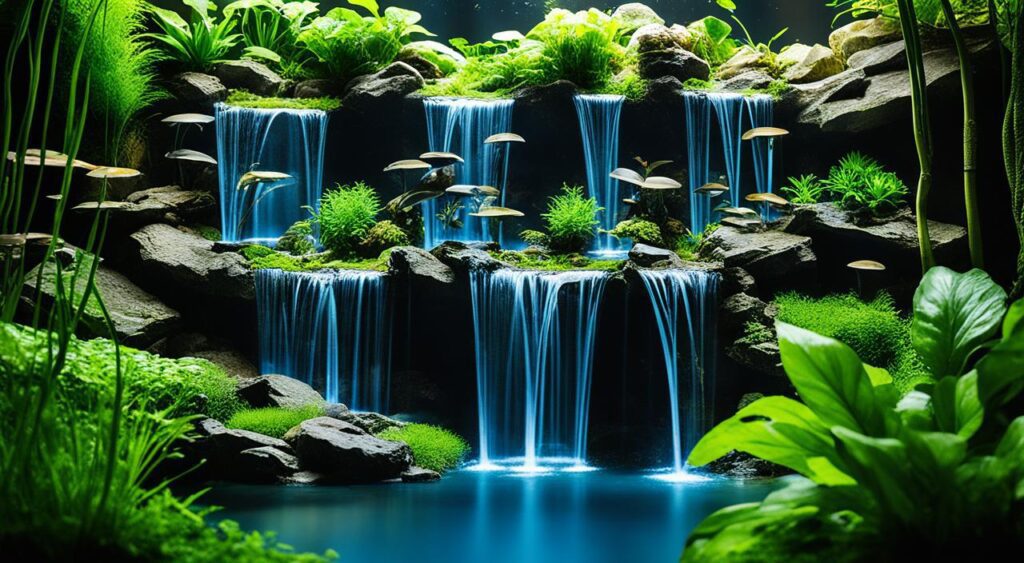
Every aquascaper’s journey begins with gathering the right tools and materials. The essence of a captivating aquascape is not only in its creativity but also in its construct’s precision. Selecting the right essentials is paramount for both the ease of assembly and the long-term success of your aquatic garden. In our aquascape material guide, I will walk you through the fundamental equipment and give you some helpful tips on hardscape selection, substrate choices, and more.
Before you lie a collection of top-notch aquascaping tools and essentials that will form the backbone of your aquatic venture, my advice comes from experience: invest wisely in quality, and your aquascape will flourish.
Choosing the Right Pond Liner
The pond liner serves as the bedrock of your aquascape, sealing the foundation and ensuring a watertight base. Selecting a pond liner that withstands natural elements and holds up against wear and tear is vital. Be sure to opt for a durable material appropriate to the scale of your envisioned water sanctuary.
Pond Pump and Filtration Fundamentals
A robust pond pump and filtration system are the heart of the aquascape’s circulation, vital for maintaining a crystal-clear view of your underwater masterpiece. Modern pumps offer energy efficiency while providing the necessary water movement. Meanwhile, the filter keeps the ecosystem healthy by removing impurities and maintaining balance.
Creating Waterfalls and Streams
My favourite aspect of aquascaping, the creation of waterfalls and streams, introduces dynamic movement, infusing the scape with vitality. Utilizing waterfall spillways and streambed kits enables the artisan to control the flow and shape of water courses, contributing to the artistic flow of the aquascape.
Below, I have prepared a succinct guide—a foundation you may build upon to bring your aquascaping vision to life. May your hands weave the elements as deftly as nature herself does.
| Equipment | Purpose | Benefits |
|---|---|---|
| High-Quality Pond Liner | Forms a secure base for the pond or water feature | Provides longevity and leakage prevention |
| Energetic Pond Pump | Ensures effective water circulation | Facilitates a healthy aquatic environment |
| Efficient Filtration System | Cleanses water, removing debris and toxins | Promotes clarity and balance within the ecosystem |
| Waterfall Spillway & Streambed Kit | Creates a controllable waterfall or stream | Adds beauty and aerates the water for healthier fish and plants |
| Diverse Substrate Selection | Acts as soil for plant growth and enhances aesthetics | Supports the aquascape’s ecological function and design |
| Varied Hardscape Materials | Provides structure and natural decoration | Frames the aquascape, giving it form and depth |
I urge you to embrace the journey of aquascaping as not just a mere hobby but as an exploration into an art form that celebrates life, water, and nature’s intrinsic beauty. Equip yourself with the essentials, and let the act of creation begin!
Choosing Flora for Your Aquascape: Diversity and Balance
My approach to selecting plants for my aquascape resembles an artist choosing colours for a canvas. It’s a fundamental aspect of aquascape plant care and a key driver of aquascaping visual aesthetics. In my experience, embracing a variety of plant types leads to a vibrant and balanced underwater tableau. Aquatic plants are chosen for their beauty and ecosystem roles — from oxygenating the waters to providing refuge for fish. Let’s delve into the diverse range of flora that can enhance your aquascape’s visual and ecological harmony.
Envision a surface dotted with floating Water Lilies, their blossoms like jewels upon the water, and Water Hyacinths with purple flowers swaying gently in the current. Below the waterline, Anacharis and Hornwort create an underwater forest teeming with life and vitality. At the margins, the vertical drama of Pickerelweed and the varied hues of Iris captivate the eye and reinforce the edges of the aquatic world I’ve created. This rich tapestry of plant life is meticulously arranged following the aquascape balance principles, ensuring each plant contributes to the overall aesthetic while fulfilling its ecological purpose.
- Floating Plants: Enliven the water’s surface and provide shade.
- Submerged Plants: Oxygenate the water and offer sanctuary to aquatic inhabitants.
- Marginal Plants: Add height and structure at the water’s edge.
Complementary to the diverse flora, my aquascape design weaves in the textures and colours of each specimen to create an engaging spectacle from every angle. Careful plant care practices, such as pruning, spacing, and feeding, maintain the aquatic plants’ health and vigour. These practices are not just for the sake of upkeep, but they also play a crucial role in preserving the delicate ecological balance within the aquascape.
| Plant Type | Visual Appeal | Ecosystem Role |
|---|---|---|
| Water Lilies (Nymphaea spp.) | Soft-hued blossoms floating on the water | Provides shading and shelter for aquatic life |
| Water Hyacinth (Eichhornia crassipes) | Vibrant purple flowers | Aids in nutrient uptaking and water filtering |
| Anacharis (Elodea canadensis) | Dense, bright greenery underwater | It supports water clarity and provides spawning grounds |
| Hornwort (Ceratophyllum demersum) | Lush, feathery fronds | Supports water clarity and provides spawning grounds |
| Pickerelweed (Pontederia cordata) | Upright growth with striking blue-purple flowers | Edges the aquascape and attracts pollinators |
| Iris (Iris spp.) | Diverse coloration | Captivates the senses and enriches the marginal plant zone |
With the right blend of plant varieties, meticulous care, and aesthetic principles, aquascaping becomes more than gardening — transforming into an exercise of artistry. Here, beneath the water’s surface, the dance of plants and water crafts an ever-evolving masterpiece reflective of nature’s essence and the aquascaper’s vision.
Aquascaping Layout Tips: Crafting Your Aquatic Design
Embarking on creating an aquascape begins long before water ever kisses the earth. It starts in the imagination and swiftly moves to the drawing board—where vision and practicality converge. My mission here is to share seasoned advice on crafting an aquascape design that harmoniously blends aesthetic appeal with ecological wisdom, one that encapsulates the essence of aquascaping visual aesthetics and exemplifies aquascape design basics. Let these aquascaping layout tips guide you as you draft the blueprint of your watery paradise.
Visualizing and Planning Your Aquascape
My initial step is always to visualize the potential of the space—envisioning the water’s flow, the play of light upon the surface, and the life that will thrive here. I measure the area with meticulous care; much like any great work of art, an aquascape demands a firm groundwork to prosper. Planning goes beyond mere aesthetics; it necessitates understanding the natural ecosystem. This ranges from the depth required for fish to swim freely to the range of plant species that will adorn the newly created water-feature landscape.
Building the Pond and Water Features
My journey led me to carve out the pond, guided by the design sketch. As I shape the basin, my hands work intently and precisely, carefully accommodating the silent stones and the vibrant life they will soon host. A pond liner matched neatly to the pond’s shape secures this enclave from seeping away into the earth. With the basin set, I construct waterfalls and streams, placing the spillway with deliberation to simulate the casual charm of a natural brook—a dance between the man-made and the natural world.
Strategic Placement of Aquatic Plants
The final flourish in my aquascape lies in the planting. Each aquatic flora’s designated role in this living tapestry contributes to aquascaping visual aesthetics. Whether it’s the tranquil lilies on the surface or the hardy reeds that line the pond’s border, I place each species thoughtfully. My approach ensures they not only fulfil an ecological niche but also add to the dynamic visual tableau I aim to create. In these details, the principles of aquascape design basics merge with the intricate dance of aquascaping layout tips, and ultimately, the aquascape comes to life.
FAQ
What is the importance of choosing the right pond liner?
The importance of selecting the right pond liner cannot be overstated. It’s the foundational barrier that keeps your aquascape water contained, prevents leaks, and conforms to the shape and size of your design. A high-quality pond liner ensures longevity and durability for your aquatic oasis, providing a reliable base for the intricate ecosystem you’re creating.
How do pond pumps and filters contribute to the aquascape ecosystem?
Pond pumps and filters play a critical role in maintaining the health of your aquascape ecosystem. The pump circulates water, preventing stagnation and promoting oxygenation, while the filter cleanses the water of debris and harmful substances, preserving the clarity and quality of the water for plants and animals.
What are the key considerations when creating waterfalls and streams in an aquascape?
When crafting waterfalls and streams, it’s essential to consider the water flow rate, the sound of the water, and visual appeal. These features should mimic natural water movements, creating an aesthetically pleasing and relaxing environment. Additionally, using the right spillways and streambed kits can help achieve a seamless integration with the surrounding landscape.
How do I ensure diversity and balance when choosing flora for my aquascape?
To ensure diversity and balance in your aquascape, you should select a variety of plants that serve different functional and aesthetic purposes. Include plants with varying heights, colors, and growth habits that will provide oxygenation, filtration, and habitat for wildlife. Consider both submerged plants for water quality and floating or emergent plants for visual interest.
What are the steps involved in visualizing and planning an aquascape?
When visualizing and planning an aquascape, begin by measuring your available space and then sketching a design that incorporates your desired features such as plants, rocks, and water elements. Consider the views from various angles, how the elements will interact, and what kind of maintenance will be required. A well-thought-out plan will be your guide throughout the creation process.
What’s the best approach for building the pond and water features in an aquascape?
The best approach for building a pond and water features is to start with precise excavation according to your design, ensuring proper depth and contours. After laying a suitable liner, construct your water features with attention to detail to mimic natural landscapes. Use stones and positioning to guide the water flow and create a natural appearance.
How do I strategically place aquatic plants in my aquascape?
Strategic placement of aquatic plants in your aquascape involves considering the light requirements, growth patterns, and size of each species. Taller plants should be placed in the background, while shorter ones can be placed in the foreground. Grouping plants in odd numbers often looks more natural, and allowing space for growth is also essential for a balanced appearance.
What lighting should be used in aquascaping?
The lighting for aquascaping should be selected based on the needs of the plants and the overall aesthetic you wish to achieve. LED lights are popular options that provide a full spectrum of light, encouraging healthy plant growth and illuminating your aquascape for maximum visual impact. The light intensity and duration should be controlled to match the natural rhythm of day and night.
How important are water parameters in an aquascape, and how do I maintain them?
Water parameters are crucial in an aquascape as they directly affect the health of the plants and animals living in the ecosystem. You should regularly test and adjust the pH, hardness, temperature, and nutrient levels to create an optimal environment. Regular maintenance, water changes, and monitoring will help keep these parameters within the desired ranges.
What essential tools do I need for aquascaping?
Essential tools for aquascaping include aquatic plant scissors for trimming, tweezers for plant placement, substrate rakes for leveling, and gravel vacuums for cleaning. Having the proper equipment will facilitate plant care, hardscape arrangement, and overall maintenance of your aquascape.
How often should I perform maintenance on my aquascape?
Regular maintenance is key to a thriving aquascape. Weekly tasks might include checking water parameters, cleaning the substrate, and trimming plants. Monthly maintenance could involve cleaning filters, checking equipment functionality, and making water changes. The consistency and frequency of these tasks keep your aquascape healthy and visually appealing.
What are some aquascaping theme ideas that can enhance my aquatic landscape?
Popular aquascaping themes include the naturalistic approach, which emulates a slice of nature; the Dutch style focuses on plant variety and arrangement; Iwagumi emphasizes rocks as a central element; and biotopes aim to replicate a specific natural environment. Each theme has distinct characteristics and requirements which can enhance the aesthetic and biological richness of your aquatic landscape.
Can you explain the principles of balance in aquascaping?
Balance in aquascaping relates to the visual harmony and proportionality within the aquascape. This includes considering the rule of thirds to create focal points, ensuring a mix of plant and hardscape sizes, using colors effectively, and paying attention to the overall scale within the aquarium or pond to create a pleasing and unified composition.

